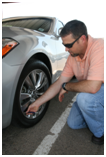Pros and cons of using Nitrogen to inflate your tires (Part 3)
This is part 3 of our series on using Nitrogen to inflate your tires.
· Click here for part one.
· Click here for part two.

Drawbacks you can expect when using nitrogen inflation.
1. Regardless of its ability to stay put within the tire, nitrogen is still a gas and eventually you will need to restore the pressure of your tires by topping them off. When this happens, nitrogen can only be topped off by nitrogen. The alternative, which is filling it up using compressed air, is a slow and tedious affair that involves deflating the tire completely before re-inflating it using compressed air.
2. To fill your tires with nitrogen, you will need to dig deeper into your pockets. It might save you money at the pump due to the improved fuel consumption of your vehicle but be prepared to cough up a little more when refilling your tires. A worthy compromise? Not entirely because at the end of the day you are still paying for fuel.

Nitrogen inflation: Is it worth it?
A lot of unjustified skepticism surrounds the topic of nitrogen filling. Some people feel like the increased cost is just not worth the benefits that come with it. Some have even suggested that the same effect can be achieved using compressed air by regularly checking and maintaining the tire pressure of the vehicle. Let's face it, not many drivers will do this as often as is required and at the end of the day, they will still suffer the detrimental effects of under inflation, not to mention corrosion and increased pressure when the tires heat up.
It seems like such a small cost compared to the number of ways it improves the general functionality of your vehicle.
You can schedule an appointment with us.
Schedule Serivce
Our locations are:
· 106-01 Northern Blvd. Corona, NY 11368
· 79-20 Queens Blvd. Elmhurst, NY 11373
· 118-02 Merrick Blvd. Jamaica, NY 11434
· 79-20 108th St. Corona, NY 11368